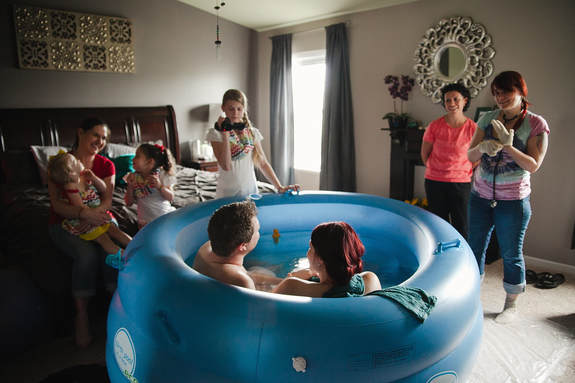Benefits of Hydrotherapy
Hydrotherapy (water therapy) is known to have many benefits in labor and childbirth. Laboring in the water may be a good choice for many people, whether you choose to give birth in water or not.
Benefits of water immersion in labor & birth include:
- Buoyancy in water relieves the woman of supporting her full weight. This facilitates mobility and enables you to assume any position which is comfortable for labor and birth
- Buoyancy also assists in spontaneous rotation of the baby, helping the baby position for birthing
- Can speed up labor
- Can reduce blood pressure and swelling
- Provides significant pain relief
- Promotes relaxation
- Conserves your energy
- Reduces the need for drugs and interventions
- Reduces perineal trauma
- Is highly rated by everyone who has utilized it and experienced providers
- Encourages an easier birth and a gentler welcome for baby
Waterbirth FAQ
What prevents baby from breathing under water?
According to Waterbirth International, there are four main factors that prevent the baby from inhaling water at the time of birth:
1. Prostaglandin E2 levels from the placenta which cause a slowing down or stopping of the fetal breathing movements. When the baby is born and the Prostaglandin level is still high, the baby’s muscles for breathing simply don’t work, thus engaging the first inhibitory response.
2. All babies are born experiencing mild hypoxia or lack of oxygen. Hypoxia causes apnea and swallowing, not breathing or gasping.
3. Fetal lungs are already filled with fluid. That fluid is there to protect the lungs, and keep the spaces open that will eventually exchange carbon dioxide and oxygen. It is very difficult, if not impossible, for fluids from the birth tub to pass into those spaces that are already filled with fluid. One physiologist states that “the viscosity of the fluid naturally occurring in the lungs is so thick that it would be nearly impossible for any other fluids to enter.”
4. The last important inhibitory factor is the Dive Reflex and revolves around the larynx. The larynx is covered all over with chemoreceptors or taste buds. The larynx has five times as many as taste buds as the whole surface of the tongue. S, when a solution hits the back of the throat, passing the larynx, the taste buds interprets what substance it is and the glottis automatically closes and the solution is then swallowed, not inhaled.
1. Prostaglandin E2 levels from the placenta which cause a slowing down or stopping of the fetal breathing movements. When the baby is born and the Prostaglandin level is still high, the baby’s muscles for breathing simply don’t work, thus engaging the first inhibitory response.
2. All babies are born experiencing mild hypoxia or lack of oxygen. Hypoxia causes apnea and swallowing, not breathing or gasping.
3. Fetal lungs are already filled with fluid. That fluid is there to protect the lungs, and keep the spaces open that will eventually exchange carbon dioxide and oxygen. It is very difficult, if not impossible, for fluids from the birth tub to pass into those spaces that are already filled with fluid. One physiologist states that “the viscosity of the fluid naturally occurring in the lungs is so thick that it would be nearly impossible for any other fluids to enter.”
4. The last important inhibitory factor is the Dive Reflex and revolves around the larynx. The larynx is covered all over with chemoreceptors or taste buds. The larynx has five times as many as taste buds as the whole surface of the tongue. S, when a solution hits the back of the throat, passing the larynx, the taste buds interprets what substance it is and the glottis automatically closes and the solution is then swallowed, not inhaled.
Is there an increased risk for infection?
According to Anne Frye in Holistic Midwifery Volume II, there is not an increased risk of maternal infection with waterbirth. Barbara Harper, founder of Waterbirth International and author of Gentle Birth Choices, notes that,
‘During labor everything is moving down and out. The baby is descending into the birth canal. It does not make sense that bacteria from the water would go up into the uterus. In fact, the concentration of bacteria in and around the vagina is actually diluted by the water, lessening the possibility of infection.’ (see video below)
Additional Resources:
Barbara Harper’s Waterbirth Basics (pdf)
Waterbirth International
‘During labor everything is moving down and out. The baby is descending into the birth canal. It does not make sense that bacteria from the water would go up into the uterus. In fact, the concentration of bacteria in and around the vagina is actually diluted by the water, lessening the possibility of infection.’ (see video below)
Additional Resources:
Barbara Harper’s Waterbirth Basics (pdf)
Waterbirth International
Proudly powered by Weebly

